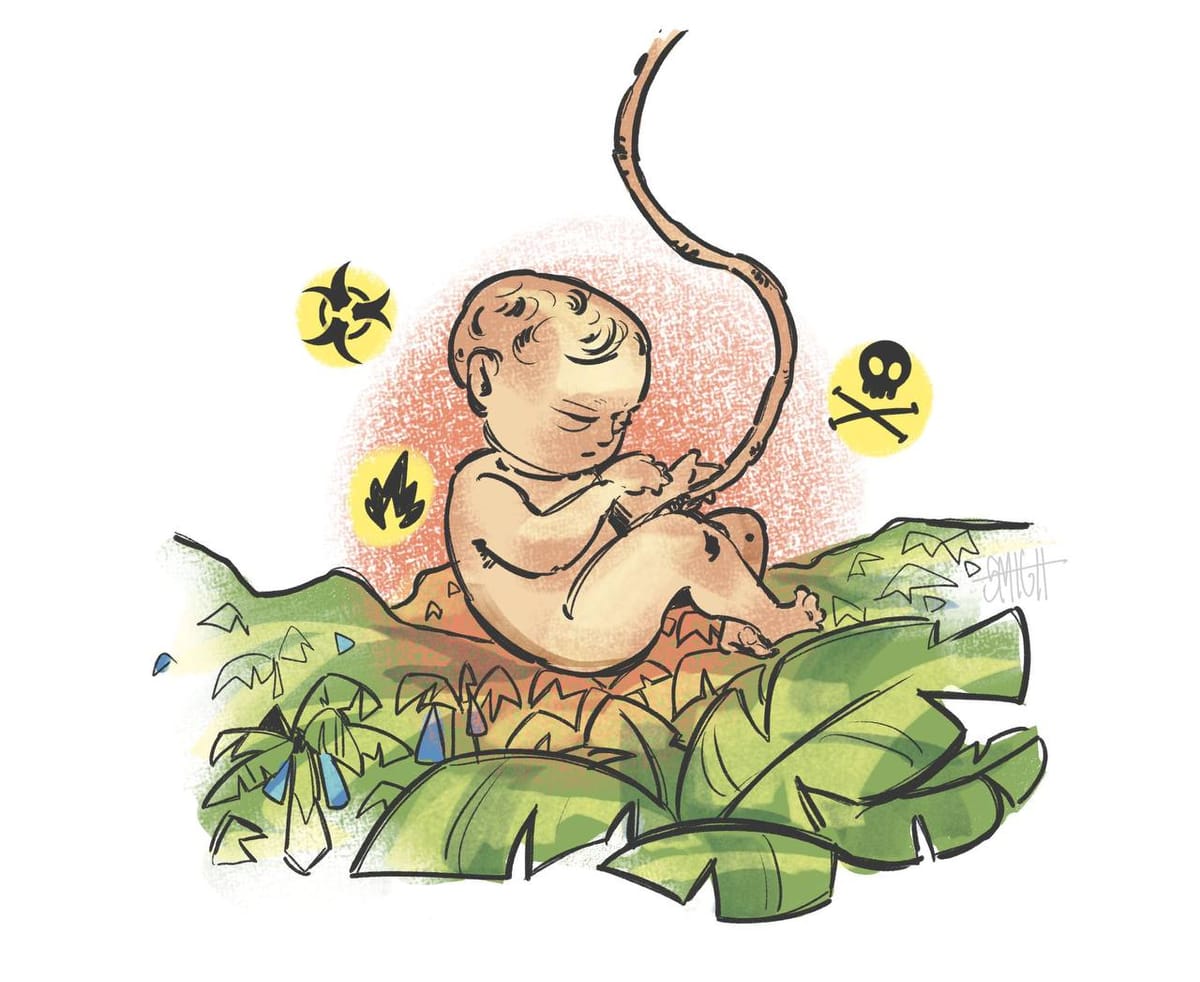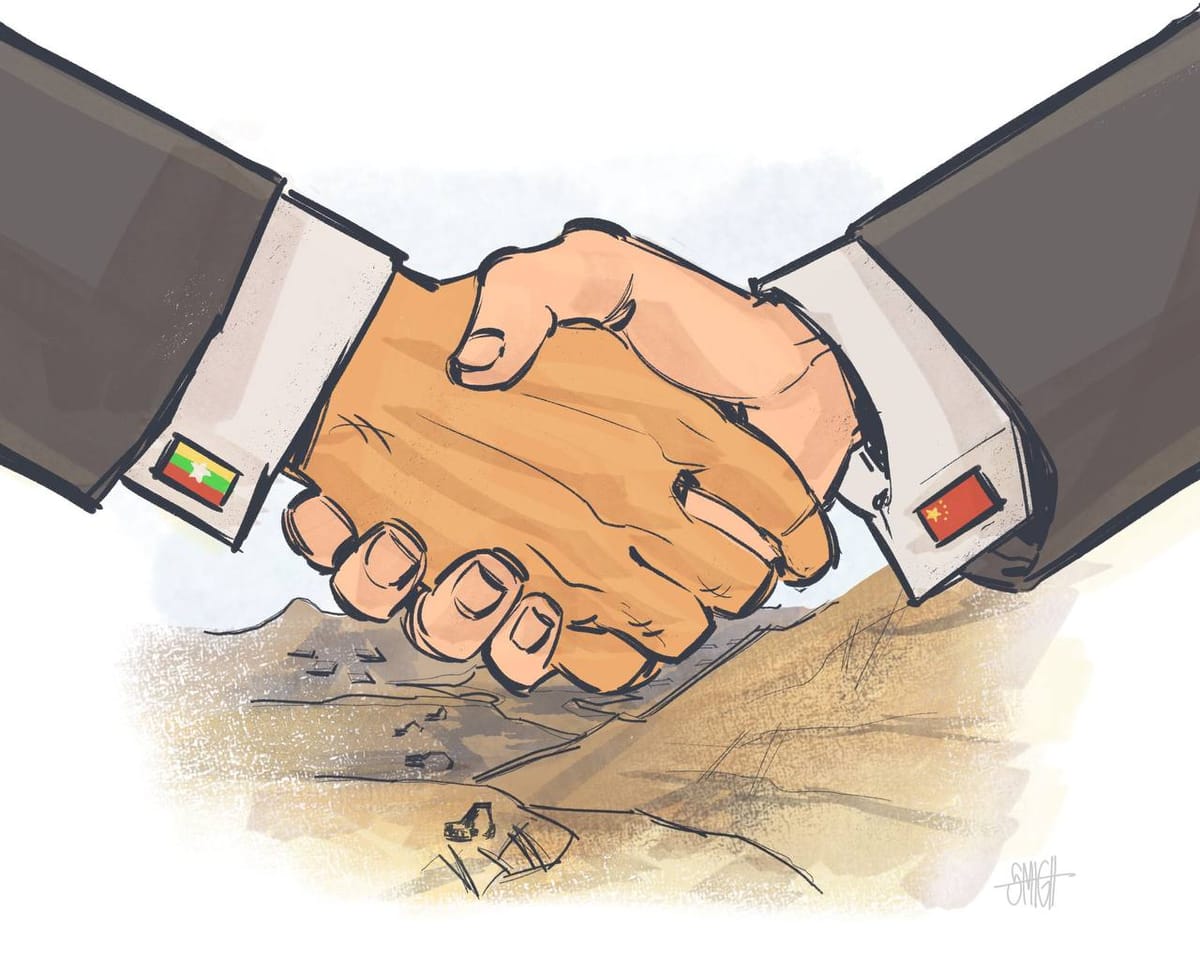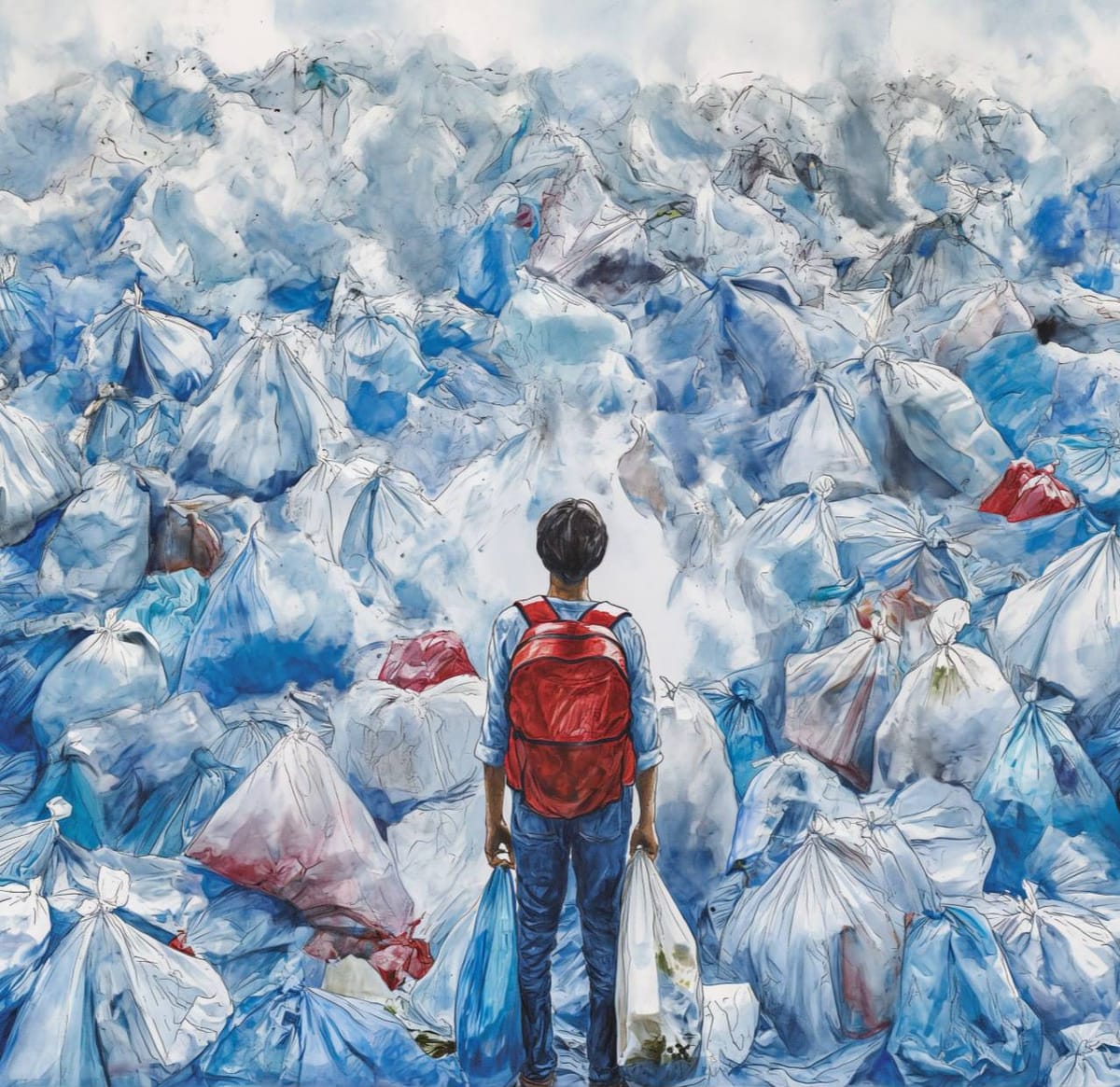
The Myitkyina Journal recently reported a critical case of a three-month-old infant requiring urgent surgery due to increasing fluid accumulation in the brain, causing progressive head enlargement. The infant's parents are workers at tissue-culture banana plantations, with the mother having worked during pregnancy in fields where she was exposed to pesticides while removing leaves, flowers, and weeds from treated plants.
The child's severe health condition appears directly linked to these tissue-culture banana plantations.
Globally recognized as a crop with numerous associated problems, tissue-culture bananas have nevertheless gained significant ground in Myanmar's Kachin State. Chinese tissue-culture banana operations now dominate the region, with plantations spanning tens of thousands of acres, evolving into a national concern.
Understanding Tissue-Culture Bananas
Simply put, tissue-culture bananas are those propagated through tissue culture methods. This process involves reproducing plant cells and tissues in laboratory conditions while preserving the mother plant's genetic makeup. This technique yields young plants identical in quality to the mother plant, maintaining genetic consistency for up to two generations.
Traditional banana cultivation relies on shoots for propagation, with each banana plant producing only four to five shoots. In contrast, tissue culture can generate countless genetically identical seedlings.
Tissue-culture bananas boast several advantages: they're disease-free, high-quality, and produce fruit earlier than traditionally propagated plants. The plants grow uniformly and can be cultivated year-round, with over 95% of plants yielding fruit. Each acre can accommodate approximately 1,400 plants.
These benefits have made tissue-culture banana cultivation an attractive, profitable venture, leading to its rapid expansion.
How Tissue-Culture Bananas Entered Myanmar
These plantations first appeared in Myanmar in 2006, introduced from China's Yunnan Province as an opium substitution crop. Initial cultivation began in the upper regions of Waingmaw Township in Kachin State and the Manwein area.
By 2016-2017, plantations had spread beyond traditional growing areas to lower Waingmaw Township, Myitkyina, Bhamo, Momauk, Mansi, and Shwegu. They've now extended into Shan State, Ayeyarwady Region, and Sagaing Region.
Kachin State remains the largest producer, with Waingmaw Township alone hosting over 100,000 acres of banana plantations.
From China to China
Everything in tissue-culture banana cultivation - from seedlings to pesticides, herbicides, and fertilizers - comes directly from China. Chinese nationals dominate the industry. Even the plastic materials used in plantations are manufactured in Myanmar using raw materials from China. Nearly all produced bananas are exported back to China by land.
The Kachin State Crop Producers Association facilitates services, working with Chinese merchants and producers. These monoculture plantations represent one of the most visible signs of China's economic expansion.
The Mekong Region Land Governance report indicates that by 2019, nearly 170,000 acres of Kachin State land had been converted to tissue-culture banana plantations. The Land Security and Environmental Conservation Network reported 140,000 acres in their 2019 final count. However, ministry registration records show only 70,000 acres.
This discrepancy reveals the extent of unauthorized tissue-culture banana operations flourishing in Myanmar.
While Chinese companies and large banana corporations reap the profits, local communities bear the negative consequences of these plantations.
Land Grabbing
What began as "experimental planting" in Kachin soil in 2006 expanded to hundreds of thousands of acres by 2016. This rapid expansion was possible through both legal and forced land acquisitions.
When intense fighting between government forces and the KIA resumed in June 2011, local Kachin and Shan residents fled their homes and farmland as IDPs. Chinese tissue-culture banana growers seized this opportunity to expand their plantations freely. Many IDP-owned agricultural lands were converted into banana plantations.
Under the 2012 Land Law, banana plantation areas in Kachin State are designated as vacant, fallow, or virgin land. However, these lands were traditionally cultivated by local villagers who lack formal documentation and generally don't understand land law implications.
Most IDPs in refugee camps couldn't even read the government offices' 30-day objection notices regarding land use, let alone file objections.
Chinese investors and their Myanmar partner companies exploited this situation by hiring brokers. These brokers would visit IDP camps to arrange land lease contracts, promising this would protect against land seizure. In reality, these lease agreements were merely paper agreements without legal force. Smaller landowners often lost their land entirely without any consultation.
Some locals received rental payments through lease agreements, but these were often secured through misinformation, threats, or pressure, resulting in minimal compensation.
When many long-term IDPs returned home, they found they had lost not only their land but also their livelihood opportunities. Neither the state government nor local authorities provided effective solutions.
Currently, tissue-culture banana plantations have spread beyond government-controlled areas into territories controlled by people's militias and the KIA.
Labor Exploitation
The tissue-culture banana industry represents the second-largest concentration of migrant workers in Myanmar after the Hpakant jade mining area. These plantations employ between 70,000 to 80,000 workers from across Myanmar, with the majority being Bamar from central Myanmar and Rakhine from Rakhine State.
Workers come individually or as couples and families, living on the plantations throughout the season. They operate under a system called "Kyin-Sar," where workers maintain a certain number of plants - from 3,000 to 10,000 or more, depending on their capacity. Individual workers typically manage around 3,000 plants, while families handle 5,000 or more.
Bananas are purchased by weight rather than bunch, with companies and business owners setting fixed prices regardless of market rates. The purchasing standards are extremely strict - even slight blemishes result in rejection, and total crop failure means no compensation for labor.
According to the Mekong Region Land Governance report, a worker managing around 10,000 plants (equivalent to over five acres) might earn about 7 million kyats per year.
Workers endure poor living conditions year-round, residing in makeshift shelters or canvas tents without proper toilets or bathrooms. They work eight-hour days with only two days off per year. During harvest, they must carry banana bunches weighing up to 120 pounds.
The workplace lacks necessary support equipment and medical care for health issues.
Furthermore, the Mekong Region Land Governance research paper notes that these plantations use Carbofuran pesticide, which is banned in most countries. This pesticide can cause lung cancer and is toxic to other plants and living organisms. Its widespread use throughout the plantations significantly impacts both environmental and worker health.
Female workers have reported miscarriages and births of children with disabilities.
Environmental Impact
While not as visibly destructive as resource extraction with heavy machinery, tissue-culture banana plantations cause significant environmental damage.
The industry uses excessive amounts of plastic from fruiting to plant removal. Banana bunches are wrapped in multiple layers of plastic, and plants are tied together with plastic to prevent tipping. Each group of 500 plants uses nearly 80 viss of plastic. With over 100,000 acres of plantations containing more than 200 million plants, this amounts to over 300,000 viss (or 5,000 tons) of plastic used annually.
After harvesting, the plants are cut down and burned, including the plastic, which melts into large black sheets that remain in the soil. This makes the land unusable for future farming, as the buried plastic prevents root penetration. Some farmers attempt to plow the plastic under, but this is only a short-term solution that doesn't address the fundamental issue.
Without proper plastic waste management, the soil faces severe degradation. The unmanaged plastic waste accumulates in agricultural lands and waterways, eventually reaching the Irrawaddy River.
This affects water resources and fishing communities. The plastic waste from banana plantations degrades water quality, disrupting aquatic ecosystems and raising concerns about drinking water safety.
Fishers report that rivers around Kachin State once yielded fish weighing over ten viss annually, but catches have significantly decreased in recent years. This threatens both the ecosystem and food security.
Whose Interests Are Being Served?
Examining tissue-culture banana cultivation raises questions, particularly about whose interests are being served by allowing these operations on Myanmar's soil.
Chinese companies cultivate tissue-culture bananas on Myanmar land, both legally and illegally. Myanmar citizens receive only minimal land rental fees, while workers face exploitation. Worse still is the irreversible environmental damage. This begs the question: who truly benefits from tissue-culture banana cultivation? Despite outcries from locals and those affected by these plantations, the industry continues to expand.
By Nu Thet Moe (Y3A)
Read More:
 Build Myanmar - MediaY3A
Build Myanmar - MediaY3A
 Build Myanmar - MediaY3A
Build Myanmar - MediaY3A
Build Myanmar-Media : Insights | Empowering Myanmar Youth, Culture, and Innovation
Build Myanmar-Media Insights brings you in-depth articles that cover the intersection of Myanmar’s rich culture, youth empowerment, and the latest developments in technology and business.
Sign up for Build Myanmar - Media
Myanmar's leading Media Brand focusing on rebuilding Myanmar. We cover emerging tech, youth development and market insights.
No spam. Unsubscribe anytime.
Sign up now to get the latest insights directly to your mailbox from the Myanmar's No.1 Tech and Business media source.
📅 New content every week, featuring stories that connect Myanmar’s heritage with its future.
📰 Explore more:
- Website: https://www.buildmyanmarmedia.com/
- Facebook: https://www.facebook.com/buildmyanmar
- YouTube: https://youtube.com/@buildmyanmarmedia
- Telegram: https://t.me/+6_0G6CLwrwMwZTIx
- Inquiry: info@buildmyanmar.org
#BuildMyanmarNews #DailyNewsMyanmar #MyanmarUpdates #MyanmarNews #BuildMyanmarMedia #Myanmarliterature #myanmararticle #Updates #Insights #Media
